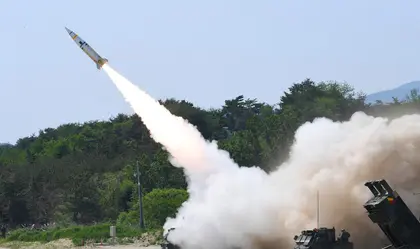Russian forces are reportedly experimenting with an automated evasion system for their reconnaissance UAVs to counter Ukrainian anti-aircraft drones, according to Defense Express.
The system involves rear-view cameras with wide viewing angles and machine vision, which analyzes footage and initiates evasive maneuvers when a threat is detected.
JOIN US ON TELEGRAM
Follow our coverage of the war on the @Kyivpost_official.
According to Defense Express, when a Ukrainian FPV interceptor drone closes in, the Russian reconnaissance UAV performs a side dive, potentially disrupting the attacker’s line of sight and delaying subsequent strikes. This delay can be critical since anti-aircraft drones have limited airtime, reducing their ability to execute follow-up attacks.
These adaptations are still in the testing stages with prototypes initially showcased by Russian developers. The system was highlighted by Serhii Beskrestnov, a Ukrainian military consultant specializing in communications and electronic warfare, who shares insights under the pseudonym “Flash.”
A Ukrainian aerial scout confirmed to Kyiv Post that the Russian developments are noticeable, largely due to “technologies that have already undergone significant improvements.”
Commenting on the Russians’ use of machine vision, the scout said that while “the technology is still raw, it has potential for further development.” He added that countermeasures could include high-speed interception tactics or fragmentation munitions that would create a cloud of debris, causing critical damage to the UAV from a safe distance.

Inside the South Korean Weapons Factory That Could Supply Kyiv
The scout suggested that a recently published Russian video demonstrating the evasion technology is likely intended as propaganda to boost morale among Russian drone operators.
He also highlighted Russia’s recent claim to have adjusted the flight altitude of its reconnaissance drones to avoid Ukrainian kamikaze attacks. However, this adjustment reportedly compromised the quality of the intelligence collected, and Ukrainian multi-copters continued to successfully target Russian UAVs despite the change.
In September, Kyiv Post also cited Beskrestnov, reporting that Russian reconnaissance drone operators had started fitting their UAVs with rear-view cameras to monitor for approaching anti-aircraft FPV drones. This adaptation was discovered when Ukrainian forces downed a ZALA 42 reconnaissance UAV, equipped with a custom-made rear-view camera device.
Reports indicated that the rear-facing camera would allow the drone to identify incoming threats, but Defense Express questioned the tactic’s efficacy. Given that reconnaissance drones are not built for aerial maneuvering, they lack the agility required to fully evade attacks.
Despite these limitations, Defense Express acknowledged the rapid pace at which Russian forces have adopted countermeasures against Ukrainian drone tactics. The media outlet speculated that further developments could include the addition of electronic warfare devices to Russian reconnaissance UAVs to disrupt common drone frequencies.
In a related report, Defense Express outlined Ukrainian forces’ growing use of anti-aircraft FPV drones to target Russian UAVs. Russian forces have reportedly responded with another unique tactic—attaching nails to their drones for “air battles.” The nails are intended to damage enemy drone rotors, causing them to crash, while the “nail drone” can return intact.
However, a Ukrainian FPV drone operator speaking to Kyiv Post dismissed this approach, explaining that the added weight from nails would likely reduce the drone’s effectiveness in combat, offering a limited advantage.
You can also highlight the text and press Ctrl + Enter






